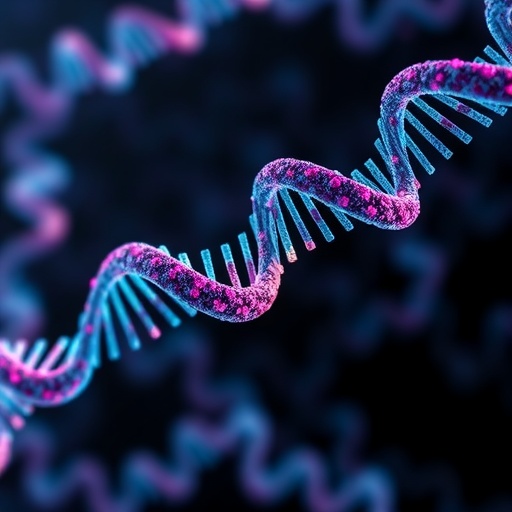In a monumental leap forward for genetics and cancer research, scientists at the Spanish National Cancer Research Centre (CNIO) have unveiled the “human REPAIRome,” a comprehensive catalog that systematically maps how each of the approximately 20,000 human genes impacts the repair of DNA double-strand breaks (DSBs). Published in the prestigious journal Science, this groundbreaking resource offers deep insights into the mutational footprints left behind after DNA repair and holds transformative potential for personalized cancer therapies and the refinement of genome-editing technologies.
DNA integrity is vital for cellular life, yet the molecule is perpetually subjected to spontaneous and environmental damage. Among the most deleterious lesions are double-strand breaks—where both strands of the DNA helix are severed simultaneously. Such breaks can arise from routine cellular processes, ultraviolet sunlight exposure, or even therapeutic interventions like chemotherapy and radiotherapy. Left unrepaired or misrepaired, these breaks can drive mutation accumulation, chromosomal instability, and ultimately oncogenesis. Understanding the molecular choreography behind repair pathways is therefore paramount for both fundamental biology and clinical applications.
The concept underlying the REPAIRome is elegantly simple but profoundly informative: every DNA repair event leaves a unique “scar” or mutational footprint—a pattern of genetic alterations that serve as a molecular diary of the damage incurred and the mechanisms deployed to mend it. Just as dermatological scars reveal the nature of skin injuries, these mutational fingerprints offer detailed narratives about the types of breaks and the repair strategies engaged by the cell. Decoding these patterns enables scientists to infer the historical battlefield of genomic maintenance and its failures in diseases like cancer.
Achieving this feat required an enormous technological endeavor. The CNIO team methodically inactivated each human gene in separate, engineered cell populations—totaling nearly 20,000 distinct cell lines—thereby isolating the effect of each gene on DNA break repair fidelity. These genetically modified cells were then subjected to controlled DSBs induced by CRISPR-Cas9 gene editing, provoking repair processes that etched their mutational marks on the DNA. High-throughput sequencing and advanced computational analyses then cataloged and categorized these unique patterns, assembling a genetic atlas of repair outcomes unprecedented in scope and detail.
Crucially, this simultaneous multiplexed approach allowed the researchers to rapidly generate a holistic picture of how individual gene loss modulates repair processes, rather than limiting studies to one gene at a time. The parallelization of experimental and analytical workflows represents a powerful methodological advance in functional genomics, enabling investigators worldwide to explore gene-function relationships in DNA repair at an unparalleled scale and resolution. The REPAIRome portal is now publicly accessible, empowering researchers to cross-reference repair-defect signatures with tumor genomics and cellular phenotypes.
From a translational perspective, the implications are robust and compelling. Many cancer treatments deliberately inflict DNA damage—especially double-strand breaks—to eradicate malignant cells. However, tumor adaptation through enhanced DNA repair mechanisms frequently underlies therapeutic resistance, posing significant hurdles for clinical management. By pinpointing the altered repair landscapes associated with the absence or dysfunction of specific genes, the REPAIRome enables precision oncology strategies tailored to disrupt tumor DNA repair pathways selectively, thus overcoming resistance and improving patient outcomes.
The study also sheds light on the complex interplay of repair mechanisms and their links to particular cancer types. Notably, the CNIO researchers identified a distinctive mutational signature associated with kidney cancer and hypoxic tumor microenvironments, a finding that opens new avenues for targeted therapeutic interventions. By clarifying how hypoxia influences DNA repair fidelity and mutation accumulation, this insight could guide the development of hypoxia-modulating agents or repair pathway inhibitors as adjunct treatments.
Beyond oncology, the REPAIRome carries significant promise for the burgeoning field of gene editing. CRISPR-Cas systems, which operate by inducing site-specific double-strand breaks to enable genome modifications, stand to benefit from an in-depth understanding of the cellular repair mechanisms that follow DNA cleavage. Ensuring accurate and predictable repair outcomes is critical for the safety and efficacy of gene therapies. The detailed genetic landscape provided by the REPAIRome paves the way for refining editing protocols, minimizing off-target effects, and achieving precise gene correction.
The development of the REPAIRome was a multidisciplinary effort, combining experimental molecular biology, state-of-the-art computational genomics, and structural biology expertise. Researchers integrated innovative data analysis and visualization tools to interpret the vast amount of sequencing data generated. This computational prowess enabled mapping the comprehensive impact of gene disruptions on repair signatures, underscoring the symbiosis between wet-lab experimentation and bioinformatics in modern biomedical research.
In framing their findings, the CNIO team emphasized the REPAIRome as “a powerful resource for the scientific community,” anticipating its broad utility not only in cancer biology and genomics but also for biotechnological applications. The portal represents an open platform for discovery, allowing hypothesis-driven interrogation of DNA repair pathways and fostering novel insights into genome stability, mutation processes, and cellular responses to genotoxic stress.
This monumental achievement was made possible through generous funding by Spanish and European public entities, including the Ministry of Science, Innovation and Universities, the Spanish Research Agency (AEI), and the European Regional Development Fund. Additional support came from prominent private foundations, underscoring the collaborative nature of contemporary scientific progress.
The human REPAIRome stands as a testament to the power of integrative science, offering a molecular blueprint of the intricate dance between DNA damage and repair. It sets a new standard in our capacity to link genotypic alterations with phenotypic consequences and presents a tangible pathway toward revolutionizing cancer treatment and gene editing technology. As this catalogue continues to be explored and expanded, its full impact across medicine and biology is poised to be both transformative and enduring.
Subject of Research: Cells
Article Title: A comprehensive genetic catalog of human double-strand break repair
News Publication Date: 2-Oct-2025
Web References: http://dx.doi.org/10.1126/science.adr5048
Image Credits: Marina Bejarano / CNIO
Keywords: DNA repair, DNA damage, Mutation, Human genetics, Cancer, CRISPRs, Kidney cancer, Gene editing, Cancer treatments




